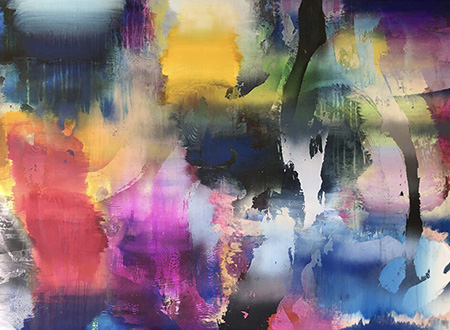
Continuing through August 19, 2023
To say that Chris Trueman’s current works are superficial is to describe them, not denigrate them. By concentrating on various materials, process and application approaches, the 45-year-old artist rejects any illusionism or the shallow space associated with Cubism and other Modernist practices. It’s a stretch even to say they are abstract, for what are they abstracting? Landscape is a forgotten dream in these works, lacking any residual horizon or slanted daylight streaming into view.
What the viewer gains instead is a forthright confrontation with slathered, sprayed-on, brushed and scraped paint in various conglomerations, sizes, and shape-clusters, all of which ultimately coheres into convincing compositions. Any tension visible in these exhilarating and perplexing paintings is between forces of declarative execution and reconsidered erasure. The gestures of Abstract Expressionism to which some of his California critics have compared Trueman’s work are more glances at an art-history book or a borrowed technical device than any serious addressing of the past.
Totally present in the current moment, these paintings express an instantaneous quality that at any time can evaporate or be ignored. The felicitous color combinations are at their best when they are less harmonious, using primary tones like red, yellow and blue, more theoretical, although “theoretical” is stretching their meaning, too, so subjective and improvisatory do they appear. Second-guessing any artistic intention can be futile in that historical allusions and contemporary analogies to other artists, for Trueman, are more like fleeting handshakes or waves at distant, if welcome, forerunners. Much more satisfyingly, in this work hedonistic optical pleasures displace any deep art-historical links.
Exuberant and densely packed, each composition demands its own self-contained status. Each provides us with a panoply of luscious painterly passages without recourse to any social or political references, let alone conceptual tactics. Trueman’s sensual constructions soothe the viewer, with large horizontally sunny bands of color that embrace us, as in “LLA,” with its lower curved arch area that pretends to point to an inner, distant space, a never-never land that is impossible to attain given the enrobing stacks of blues, greens, reds and oranges that loosely surround the arch.
Elsewhere, in the taller “INTE,” a ghostly stack of various bands of blue strides forth from the middle on a flat white background, contrasting with the pink and grey clouds beside it, or scattered black and yellow smog hovering above it. These are studio landscapes, strictly metaphorical in character, denying the natural environment. The results are a kind of absolute painting, not absolute abstraction, but a refreshing non-representational icon that appears interchangeable across continents, including Australia, Italy, China, Japan and France, where his art has met with knowing appreciation. Perhaps the Europeans better acknowledge Trueman’s debts to the European origins of modernist abstraction without his re-inventing their tropes or devices. Constantly referring to social media, Instagram and computer screen savers in interviews, Trueman has re-framed the context for inspecting and understanding his art, an aesthetic based on manipulation of mechanically adjusted sources, yet one that still has the reassuring touch of the human hand.
Come to think of it, there may be one 20th-century artist to whom Trueman is most clearly indebted: Hans Hofmann, the exile from Munich who originated “push pull” color theory. Hofmann’s practice of placing one contrasting or complementary color next to another not only explains many of Trueman’s strategies, it also lifts from Hofmann’s flabby floating cubes; Trueman’s are much less thickly painted than the German’s.
Trueman has become a kind of soft-power Joan Mitchell without the landscapes, more akin to the soupy, droopy paint pools of Frankenthaler. At this rate, as he bolsters his “push-pull” stacks and further complicates his compositions — badly in need of evolution or renovation — Trueman will approach the status of those silent mentors of the past who never could have predicted his appearance or rise.
